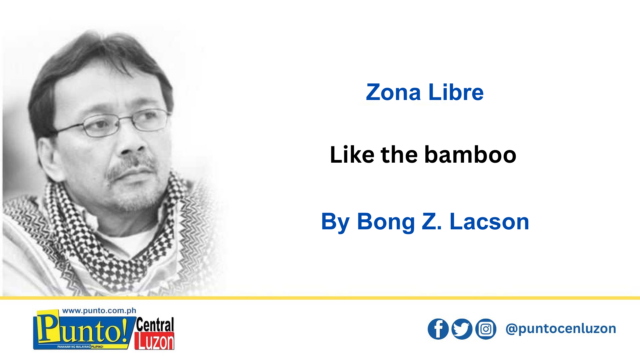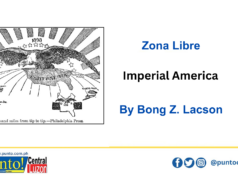MONDAY, July 7. In the course of my call at the Capitol, Nanay Gov adumbrated the priorities of her second coming at the governorship. Of the myriad programs that span the whole socio-economic-infrastructure spectrum of development, it was her upland agroforestry program that struck a lilting chord in me, especially hearing that bamboo is at its very core.
It was something like going full circle, fading memory still distinctly remembering something with bamboos in then-Nanay Baby’s very first term.
Monday, July 16, 2012. Indeed, in this Punto! corner: Wisdom from the bamboo
PLANT BAMBOOS by the riverbanks to prevent erosion.
So, the Pampanga Bamboo and Rattan Center enjoined local government units along the coastal towns. Even as it boasts of having planted no less than 22,000 bamboo propagules all over the province, the council targets 5,000 more in August in celebration of the Bamboo Day Celebration which has been appropriated some P1 million by the provincial government.
Bamboo propagation has received a big boost with the Pampanga Agricultural College chosen as a pilot area for a 10-year research project supported by the United Nations Development Program. (Quick online check shows a Pampanga Bambusetum at the now-PSAU being a pilgrimage for benchmarking by educational institutions and LGUs.)
Rivalling, if not surpassing, the coconut as a “tree of life” for its myriad use, it gives us much pleasure now that the bamboo is getting the attention and importance it deserves.
Why, I would even go for the bamboo as national plant, not simply for its being the main component of the national house.
But for its thatched roof of nipa fronds, everything else in the bahay kubo is made of bamboo – from rafters to posts, from ceilings to walls – of sawali, down to the slatted floor.
Which manifests the wisdom of the early Filipino home builders, cool bamboo as building material being most appropriate for the hot tropics; the bahay kubo on bamboo stilts best to survive the periodic inundations from the swollen rivers in the rainy season.
Bamboo went beyond building material in Filipino life, at least the life we – the 50s plus-plus generations – knew and lived.
The bamboo took a central role in our community life
The defining spirit of Filipino communal unity and cooperation – the bayanihan – is bamboo-based. Here, the whole community helped a family relocate by carrying their whole house, with bamboo poles placed length-wise and cross-wise under the house floor, borne on the shoulders of men, the women following with pots of cool water and ladles for drinking.
The bamboo is celebrated in Filipino folk dances, from tinikling to singkil. And in song, the most famous being Lawiswis Kawayan – the sound produced by the bamboo leaves when blown by a soft breeze as backdrop to a lovers’ tryst. Originating from the Waray region, the song spread throughout the islands.
In my youth in the somnolent town of Sto. Tomas, the bamboo played as great a role as the guitar in haranas or serenades. Once the serenaders were seated at the balkonahe, the father of the girl ceremoniously accosted them with the cryptic: “Nanung mitulac quecayung mipadalan qng canacung hardin (What moved you to pass by my garden)?”
To which the guy a-courting replied: “Queni la pu macayungyung deng cuayan (It is here where the bamboos leaned to).”
In the absence of parks, much less motels, the bamboo groves did indeed make the perfect lovers’ lanes, the lawiswis of the leaves enhancing the romantic ambience.
The same bamboo groves though were made the source of children’s fears by our parents who wanted us not to loiter around during the night, the lagitic or crackling sound produced by bamboos hitting each other as they swayed to the wind said to be the voices of the patiyanac (dwarves) and other laman-labuad (enchanted creatures) who feasted on the innards of children.
Come to think of it, maybe our parents just did not want us to see forbidden things at the bamboo groves that could have abruptly ended our age of innocence.
Our elders made the bamboo as an object lesson in humility too: “Anti ca mong cuayan, cabang susucdul ca banwa qng quetasan lalu cang durucu qng gabun a quecang tatalacaran (Be like the bamboo, the higher you rise to the heavens, the more should you bow toward the earth upon which you stand).”
Keep yourself always grounded. That was what the maxim was all about.
More adages about the bamboo followed us through college – Bruce Lee revealing the bamboo as one principle of his jeet kune do: “Notice that the stiffest tree is most easily cracked, while the bamboo or willow survives by bending with the wind.”
The dragon there sharing a Buddhist teaching: “Be like bamboo. It is strong on the outside and soft and open on the inside. The stem stands freely in the wind and bends, it does not resist. What bends is harder to break.”
The bamboo well taken on a high philosophical plane there. A source of wisdom deserving indeed of the title national plant or tree.
So, what words of wisdom have you heard lately of other trees and plants?
Uh-oh: “Oo, inaamin ko, saging lang kami. Pero maghanap ka ng puno sa buong Pilipinas, saging lang ang may puso! Saging lang ang may puso! (Yes, I admit, we are only bananas. But search all trees in the whole Philippines, only bananas have hearts! Only bananas have hearts!)”
Oh please, have a heart.





